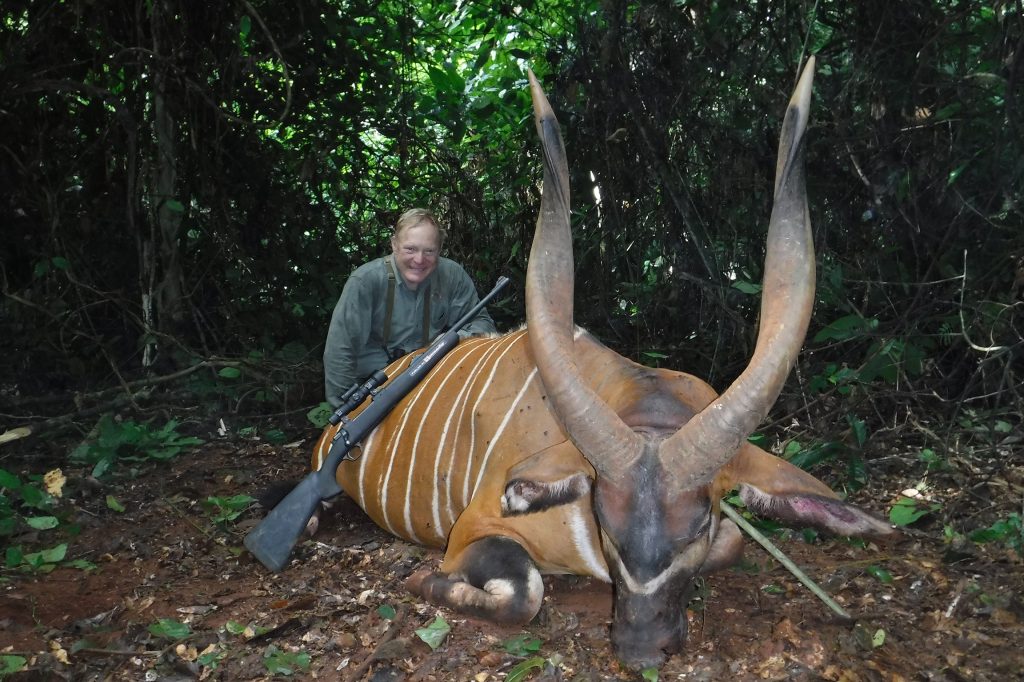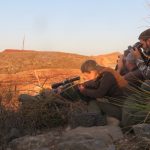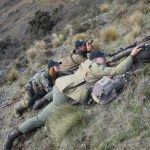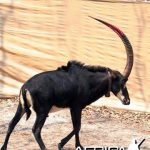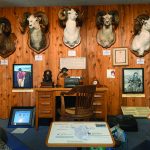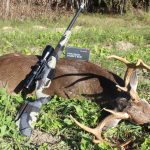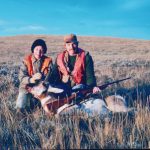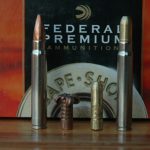All about hunting the most impressive antelope of the African forest.
Photo above: A good trail camera photo of Boddington’s 2018 Congo bongo, taken 19 days before the hunt.
When I was a kid, Warren Page’s story “Bongo in the Congo” made me want to hunt that mythical forest antelope. Page (1909-1977) was the long-time Gun Editor at Field & Steam. He is often described as “Jack O’Connor’s opposite number,” because O’Connor held the same title at Outdoor Life.
“Lefty” Page probably wouldn’t smile at that description. After leaving F&S, Page was Executive Director of the fledgling National Shooting Sports Foundation (NSSF). An avid benchrester, he was more technical than O’Connor, and contributed immensely to our knowledge of rifle accuracy. As a hunter, he didn’t take as many sheep as O’Connor, but had wide experience, and much more in Africa.
In 1957, Page was one of the first Americans to hunt bongo in the French colonies. His story created a big stir, essentially starting the Central African bongo hunting we have today. Despite the excellent article title, Page didn’t hunt in Congo. He hunted in the Congo Basin in Central African Republic (CAR). I used the same geographic subterfuge in a book chapter on my first bongo safari, also in CAR.
A seldom-seen denizen of thick, dark forest, the bongo is one of the tough ones. In 1997, Joe Bishop and I hunted for three weeks in southwestern CAR, forty-two hunting days between us. The only animal taken was my bongo. This was my second try. The year before, Sherwin Scott and I also did a three-week hunt, on the opposite side of CAR. Scotty got a nice bongo. I did not.
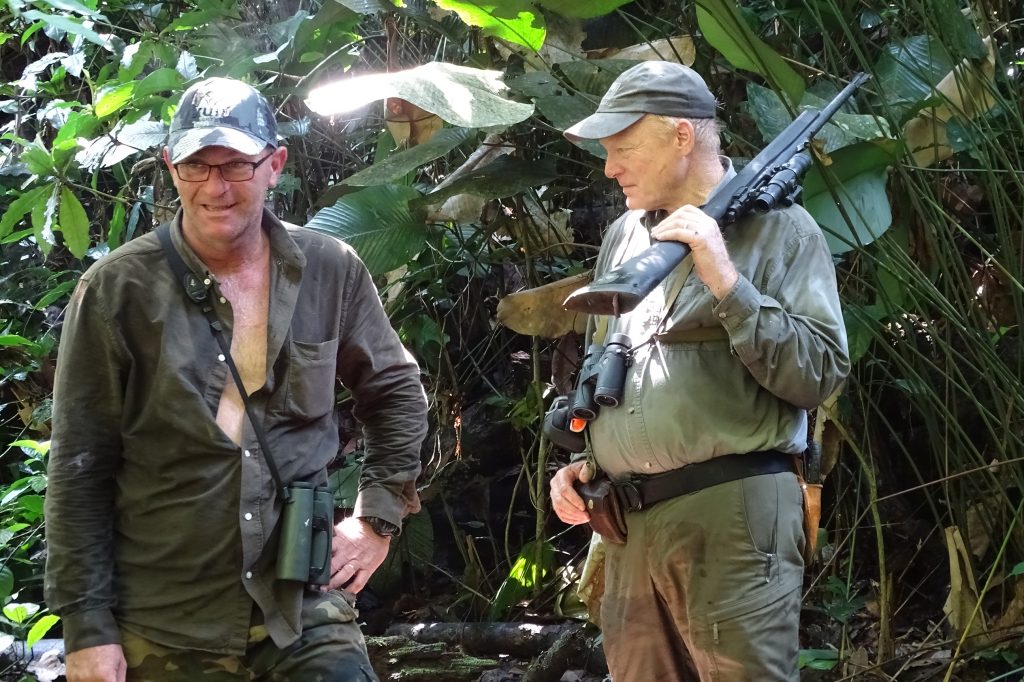
In ’96 and ’97, between Joe Bishop, Sherwin Scott, and me, we spent 84 hunting days for two bongos, six weeks of hard hunting for each. Or, if you prefer, on each 21-day safari we hit 50 percent. That was par for the course back then. Today, bongo hunting is much more successful. Like most animals, it depends somewhat on luck, and how and where one hunts them.
The bongo was first described by William Ogilby in 1837, genus Tragelaphus (“goat-deer” from Greek), species eurycerus (“broad-horn”). Initially called “broad-horned antelope,” the name bongo was first used in English in 1861, ascribed to both the Fanti and Kele native languages. The bongo is a big, blocky antelope with mature bulls weighing up to 600 pounds and more. It is one of the most colorful antelopes, with bright orange flanks, a dozen or so brilliant white vertical side-stripes, white nose chevron, black nose and darker chest, and black and white leg markings. Both sexes grow thick, smooth horns twisting in a gentle spiral. Potential length is to the upper 30 inches, with the horns of males usually thicker.
The bongo occupies a broad range across Equatorial Africa, in three distinct populations. The eastern or Kenya bongo, T, e. isaasci, is a larger subspecies, darker on neck and chest. Seriously threatened today, the Kenya bongo occurs in the high, thick bamboo forests of Mount Kenya, the Aberdares, and the Mau Forest. Not hunted since 1977, Kenya bongos were always the devil to hunt. PH Robin Hurt and James Mellon are among the last living hunters who took bongos in Kenya.
The western bongo (T. e. eurycerus) occurs from western Uganda across southwestern Sudan, southern CAR and Cameroon, the northern half of both Congos, and into Gabon. Then, there is a break across the Dahomey Gap, with bongos picking up again in Benin and Togo, ranging across southern Ghana, Ivory Coast, Liberia, and Sierra Leone into Guinea.
The bongo is so secretive that, although he was long rumored to occur in westernmost Uganda, only in 2017 was his presence confirmed by trail camera. Similarly, little is known about the current status of bongo in West Africa. It seems unlikely they still occur in Benin, Togo, or Ghana, but who knows? It’s a big forest. I saw old bongo horns in Ghana. Older local hunters I spoke to in Liberia had taken bongo, just one or two, in many years of constant hunting.
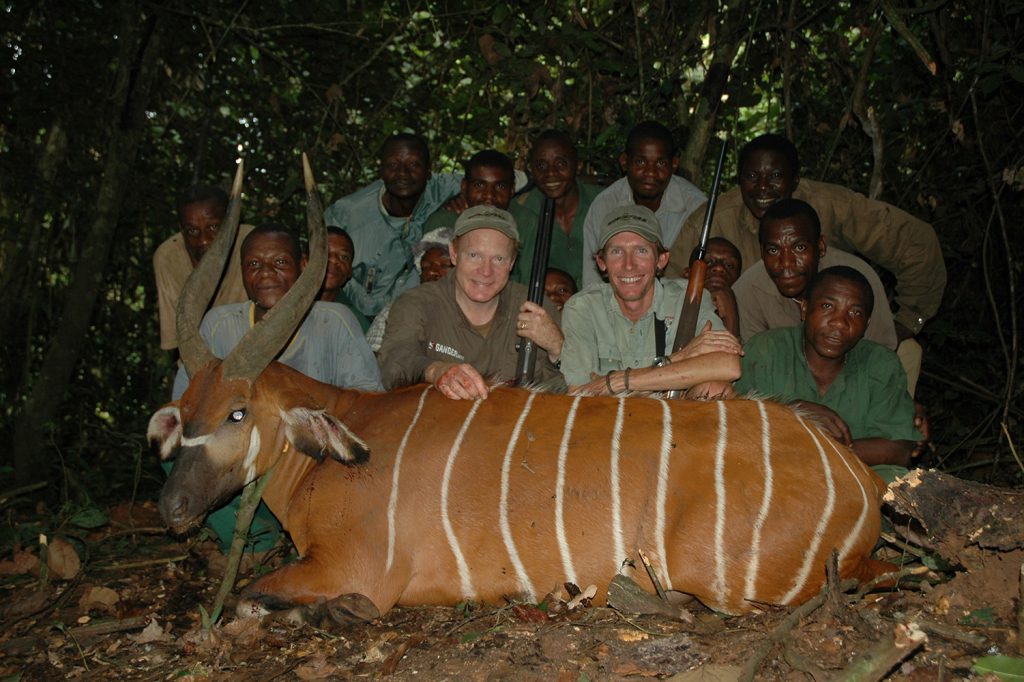
It’s a different story with the Central African population. In the heart of the forest, across southern CAR and Cameroon, and northern Congos, the bongo is plentiful, the most common large antelope. That doesn’t make him easy to hunt, but he is not scarce.
When southern Sudan was open, the bongo was hunted in “finger forest,” strands of forest broken by savanna. There, it was possible to drive bongo from patches of forest into openings. Sudan closed in 1983. Since then, we have hunted bongo in big forests to the west. It’s difficult, mitigated only by the fact that there are lots of bongos in these big forests. There are three options: Pure tracking, tracking with dogs, and sitting over clearings or mineral licks.
Warren Page shot his bongo over a large clearing surrounded by forest. In ensuing years, the same clearing accounted for several more. Natural mineral licks are a treasured feature in the region. Locating bongo bulls at licks (using tracks and trail cameras) and sitting for them is common. Especially early in the season, March and April, when it’s dry, because forest animals move more when the rains start.
Sitting works, and is not as physical as tracking. The only thing: It takes more patience than I possess. On my first bongo hunt, we got no rain the last half. (The forest adage: “No rain, no bongo.”) We sat several nights over a mineral lick with bongo tracks. I hated it. Australian friend Greg Pennicott sat it out for several nights, then shot his bongo at first light on his last day with the camp 6.5×55–not my idea of a bongo rifle. There are irascible elephants in that forest. I used a .416 Rigby for my first bongo, a borrowed Krieghoff double .500 for my second, the camp .375 Ruger for my third and last.
Tracking is hard work. But it depends on your psyche; I much prefer walking to sitting for days on end. Although pleasant after a rain, it’s usually hot and humid in the forest. But you go slowly, walking in constant shade.
I haven’t found the African forest all that buggy, although biting ants are a constant threat. Long sleeves, long trousers, and light leather gloves are necessary. Perhaps the worst is constantly ducking under vines with thorns and stinging nettles. There’s a reason why the Pygmies are short. They can jog upright down forest trails. I’m average height, and must constantly duck. I can’t imagine what it must be like for tall people. The most essential piece of forest gear: Small gardening shears, carried in belt holster, so you can snip your way through.
I mentioned there were two options for tracking, with dogs and without. There is a weird “holier than thou” belief that tracking without dogs is “better” and more ethical. I bought into this at the start of my bongo-hunting odyssey. On my first bongo safari, I heard bongos get up and crash away. I saw one flash of a red form, gone. You can’t believe how thick and dark it is in the African forest. Mount Kenya was even thicker. Tracking without dogs gave bongo hunting its reputation for low success.
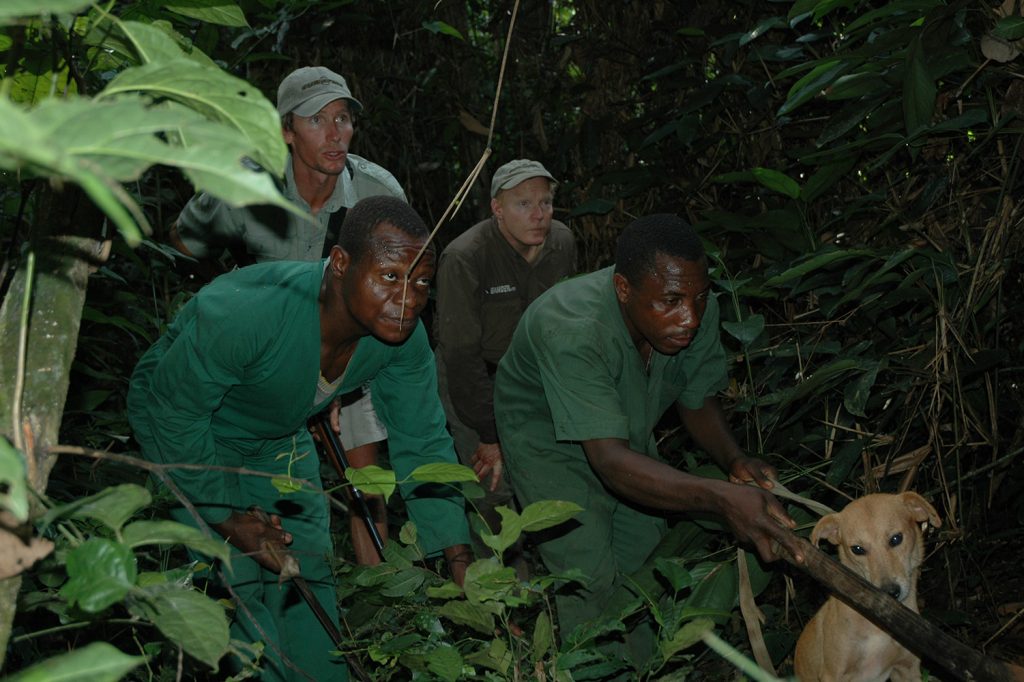
If it was ethically “better,” I’m all for it. The problem with pure tracking: You follow a big track and if you’re lucky you eventually shoot at a spot of red. Almost never will you see the horns. My first bongo, ’97, we followed a big track and I shot a patch of red. It happened to be an awesome bull, but there was no way I could know that for sure.
Bongo hunting became routinely successful when forest PHs started working with Pygmy hunters and their amazing dogs. Success is not assured, but it is far better than in days gone by. Find a big track, keep dogs leashed until the track is very fresh. There are no wild canines in the forest, so the dogs are an unfamiliar threat. It’s not a sure thing; I’ve seen bongo bulls walk away from the dogs and evaporate into the forest. Typically aggressive, like bushbucks, they will often hold for a bit and fight. Then it’s a mad scramble to get there.
Usually you see the horns. My second bongo was taken in southern Cameroon, in 2004. As usual, we found fresh bull tracks after a rain. An hour on the track, then the scramble. Not a giant bull: 27 inches, the Rowland Ward minimum. Thus, by definition, it was too good to pass. I saw the horns, knew what I was doing. No disappointment, no bonus.
My third and last bongo was in the Congo in 2018. There are lots of bongos in the Congo forest, but I wasn’t there to hunt them. I wanted a dwarf forest buffalo, generally less common and more difficult. One morning, after a rain, we couldn’t find buffalo tracks to follow. Instead, we found fresh and huge bongo tracks at a salt lick where a giant bull had been captured on trail camera. We followed through still-wet forest for an hour, found hot dung, and loosed the dogs. They jumped the bull almost immediately, then there were several desperate minutes of sprinting and slipping in mud.
The fight was in thick stuff beyond a five-yard clearing. I saw the white stripes first, then the wide, heavy horns. For sure, it was the bull on the trail camera. It was a great bongo, big in both body and horn, and without question, my best African animal.
